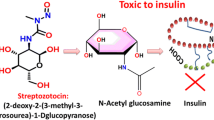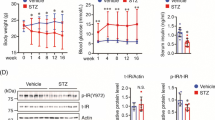Abstract
There is accumulating evidence for a pathogenetic link between sporadic Alzheimer’s disease (AD) and diabetes mellitus (DM). At subdiabetogenic doses, the cerebral administration of the diabetogenic substance streptozotocin (STZ) induces an insulin-resistant brain state (IRBS). The aim of the present pilot study was to investigate the effect of STZ on Alzheimer-like characteristics such as amyloid precursor protein (APP) cleavage secretases, betaA4 fragment, and glycogen synthase kinase (GSK) in vitro. Different STZ concentrations (0–5 mM) and incubation intervals (0–48 h) were tested to find appropriate cell culture conditions for further biochemical analyses in human neuroblastoma cells (SK-N-MC). Lactate dehydrogenase (LDH) was measured spectrophotometrically. Intracellular ATP was determined using bioluminescent luciferase assay. Secretase activity (alpha, beta, and gamma) was measured by employing commercial fluorometric secretase activity assay kits, betaA4 fragment by immunoprecipitation. Glycogen synthase kinase-3alpha/beta (total and phospho-GSK) content was assayed by ELISA technique. In vitro STZ administration (1 mM) induced a significant reduction in intracellular ATP concentration without pronounced cell death after 24 and 48 h as measured by LDH. Under these experimental conditions, a significant increase in beta-secretase and a significant drop in alpha-secretase were obtained, whereas gamma-secretase was not changed significantly. Simultaneously, the betaA4 concentration was increased by about threefold. Furthermore, STZ significantly increased total GSK and markedly decreased phospho-GSK. A direct link between STZ, intracellular ATP deficit, and Alzheimer-related enzymes was shown in this in vitro pilot study. Thus, these results support the hypothesis that sporadic AD is being recognized as an IRBS, which can be modulated by in vitro STZ model. Continuing investigations relating pathogenetic mechanisms and AD-like hallmarks are necessary to modulate different cascades of the IRBS using in vitro models.




Similar content being viewed by others
References
Adlerz L, Holback S, Multhaup G, Iverfeldt K (2007) IGF-1-induced processing of the amyloid precursor protein family Is mediated by different signaling pathways. J Biol Chem 282:10203–10209
Ali A, Hoeflich KP, Woodgett JR (2001) Glycogen synthase kinase-3: properties, functions, and regulation. Chem Rev 101:2527–2540
Bergmeyer HU, Bernt E (1974) Lactate dehydrogenase. UV-assay with pyruvate and NADH. In: Bergmeyer HU (ed) Methods of enzymatic analysis. Academic Press, New York, pp 574–579
Chen Z, Zhong C (2013) Decoding Alzheimer’s disease from perturbed cerebral glucose metabolism: implications for diagnostic and therapeutic strategies. Prog Neurobiol 108:21–43
Cuesta IG, Sánchez de Merás AM (2014) Energy interactions in amyloid-like fibrils from NNQQNY. Phys Chem Chem Phys 16:4369–4377
Cunnane S, Nugent S, Roy M, Courchesne-Loyer A, Croteau E, Tremblay S, Castellano A, Pifferi F, Bocti C, Paquet N, Begdouri H, Bentourkia M, Turcotte E, Allard M, Barberger-Gateau P, Fulop T, Rapoport SI (2011) Brain fuel metabolism, aging, and Alzheimer’s disease. Nutrition 27:3–20
de la Monte SM, Wands JR (2008) Alzheimer’s disease is type 3 diabetes-evidence reviewed. J Diabetes Sci Technol 2:1101–1113
Devi L, Alldred MJ, Ginsberg SD, Ohno M (2012) Mechanisms underlying insulin deficiency-induced acceleration of β-amyloidosis in a mouse model of Alzheimer’s disease. PLoS One 7:e32792
Ding A, Nitsch R, Hoyer S (1992) Changes in brain monoaminergic neurotransmitter concentrations in rat after intracerebroventricular injection of streptozotocin. J Cereb Blood Flow Metab 12:103–109
Duelli R, Schröck H, Kuschinsky W, Hoyer S (1994) Intracerebroventricular injection of streptozotocin induces discrete local changes in cerebral glucose utilization in rats. Int J Dev Neurosci 12:737–743
Embi N, Rylatt DB, Cohen P (1980) Glycogen synthase kinase-3 from rabbit skeletal muscle. Separation from cyclic-AMP-dependent protein kinase and phosphorylase kinase. Eur J Biochem 107:519–527
Grünblatt E, Salkovic-Petrisic M, Osmanovic J, Riederer P, Hoyer S (2007) Brain insulin system dysfunction in streptozotocin intracerebroventricularly treated rats generates hyperphosphorylated tau protein. J Neurochem 101:757–770
Hellweg R, Nitsch R, Hock C, Jaksch M, Hoyer S (1992) Nerve growth factor and choline acetyltransferase activity levels in the rat brain following experimental impairment of cerebral glucose and energy metabolism. J Neurosci Res 31:479–486
Hooper C, Killick R, Lovestone S (2008) The GSK3 hypothesis of Alzheimer’s disease. J Neurochem 104:1433–1439
Hoyer S (1992) Oxidative energy metabolism in Alzheimer brain. Studies in early-onset and late-onset cases. Mol Chem Neuropathol 16:207–224
Hoyer S (1993) Abnormalities in brain glucose utilization and its impact on cellular and molecular mechanisms in sporadic dementia of Alzheimer type. Ann N Y Acad Sci 695:77–80
Jack CR Jr, Wiste HJ, Vemuri P, Weigand SD, Senjem ML, Zeng G, Bernstein MA, Gunter JL, Pankratz VS, Aisen PS, Weiner MW, Petersen RC, Shaw LM, Trojanowski JQ, Knopman DS, Alzheimer’s Disease Neuroimaging Initiative (2010) Brain beta-amyloid measures and magnetic resonance imaging atrophy both predict time-to-progression from mild cognitive impairment to Alzheimer’s disease. Brain 133:3336–3348
Jope RS, Johnson GV (2004) The glamour and gloom of glycogen synthase kinase-3. Trends Biochem Sci 29:95–102
Junod A, Lambert AE, Orci L, Pictet R, Gonet AE, Renold AE (1967) Studies of the diabetogenic action of streptozotocin. Proc Soc Exp Biol Med 126:201–205
Kim B, Feldman EL (2012) Insulin resistance in the nervous system. Trends Endocrinol Metab 23:133–141
Lannert H, Hoyer S (1998) Intracerebroventricular administration of streptozotocin causes long-term diminutions in learning and memory abilities and in cerebral energy metabolism in adult rats. Behav Neurosci 112:1199–1208
Lester-Coll N, Rivera EJ, Soscia SJ, Doiron K, Wands JR, de la Monte SM (2006) Intracerebral streptozotocin model of type 3 diabetes: relevance to sporadic Alzheimer’s disease. J Alzheimers Dis 9:13–33
Liberman Z, Eldar-Finkelman H (2005) Serine 332 phosphorylation of insulin receptor substrate-1 by glycogen synthase kinase-3 attenuates insulin signaling. J Biol Chem 280:4422–4428
Lichtenthaler SF (2012) Alpha-secretase cleavage of the amyloid precursor protein: proteolysis regulated by signaling pathways and protein trafficking. Curr Alzheimer Res 9:165–177
Lowry OH, Rosebrough NJ, Farr AL, Randall RJ (1951) Protein measurement with the Folin phenol reagent. J Biol Chem 193:265–275
Moreira PI, Cardoso SM, Pereira CM, Santos MS, Oliveira CR (2009) Mitochondria as a therapeutic target in Alzheimer’s disease and diabetes. CNS Neurol Disord Drug Targets 8:492–511
Nitsch R, Hoyer S (1991) Local action of the diabetogenic drug, streptozotocin, on glucose and energy metabolism in rat brain cortex. Neurosci Lett 128:199–202
Pei JJ, Khatoon S, An WL, Nordlinder M, Tanaka T, Braak H, Tsujio I, Takeda M, Alafuzoff I, Winblad B, Cowburn RF, Grundke-Iqbal I, Iqbal K (2003) Role of protein kinase B in Alzheimer’s neurofibrillary pathology. Acta Neuropathol 105:381–392
Phiel CJ, Wilson CA, Lee VM, Klein PS (2003) GSK-3alpha regulates production of Alzheimer’s disease amyloid-beta peptides. Nature 423:435–439
Plaschke K, Hoyer S (1993) Action of the diabetogenic drug streptozotocin on glycolytic and glycogenolytic metabolism in adult rat brain cortex and hippocampus. Int J Dev Neurosci 11:477–483
Plaschke K, Kopitz J, Siegelin M, Schliebs R, Salkovic-Petrisic M, Riederer P, Hoyer S (2010) Insulin-resistant brain state after intracerebroventricular streptozotocin injection exacerbates Alzheimer-like changes in Tg2576 AbetaPP-overexpressing mice. J Alzheimers Dis 19:691–704
Reiman EM, Caselli RJ, Yun LS, Chen K, Bandy D, Minoshima S, Thibodeau SN, Osborne D (1996) Preclinical evidence of Alzheimer’s disease in persons homozygous for the epsilon 4 allele for apolipoprotein E. N Engl J Med 334:752–758
Salkovic-Petrisic M, Hoyer S (2007) Central insulin resistance as a trigger for sporadic Alzheimer-like pathology: an experimental approach. J Neural Transm Suppl 72:217–233
Salkovic-Petrisic M, Lackovic Z, Hoyer S, Riederer P (2005) Central administration of alloxan impairs glucose tolerance in rats. J Neural Transm 112:1391–1395
Salkovic-Petrisic M, Tribl F, Schmidt M, Hoyer S, Riederer P (2006) Alzheimer-like changes in protein kinase B and glycogen synthase kinase-3 in rat frontal cortex and hippocampus after damage to the insulin signalling pathway. J Neurochem 96:1005–1015
Salkovic-Petrisic M, Osmanovic J, Grünblatt E, Riederer P, Hoyer S (2009) Modeling sporadic Alzheimer’s disease: the insulin resistant brain state generates multiple long-term morphobiological abnormalities including hyperphosphorylated tau protein and amyloid-beta. J Alzheimers Dis 18:729–750
Selkoe DL, Yamazaki T, Citron M, Podlisny MB, Koo EH, Teplow DB, Haass C (1996) The role of APP processing and trafficking pathways in the formation of amyloid beta-protein. Ann NY Acad Sci 777:57–64
Siesjö BK (1978) Brain energy metabolism and catecholaminergic activity in hypoxia, hypercapnia and ischemia. J Neural Transm Suppl 14:17–22
Small GW, La Rue A, Komo S, Kaplan A, Mandelkern MA (1995) Predictors of cognitive change in middle-aged and older adults with memory loss. Am J Psychiatry 152:1757–1764
Steen E, Terry BM, Rivera EJ, Cannon JL, Neely TR, Tavares R, Xu XJ, Wands JR, de la Monte SM (2005) Impaired insulin and insulin-like growth factor expression and signaling mechanisms in Alzheimer’s disease–is this type 3 diabetes? J Alzheimers Dis 7:63–80
Sun X, Sato S, Murayama O, Murayama M, Park JM, Yamaguchi H, Takashima A (2002) Lithium inhibits amyloid secretion in COS7 cells transfected with amyloid precursor protein C100. Neurosci Lett 321:61–64
Velliquette RA, O’Connor T, Vassar R (2005) Energy inhibition elevates beta-secretase levels and activity and is potentially amyloidogenic in APP transgenic mice: possible early events in Alzheimer’s disease pathogenesis. J Neurosci 25:10874–10883
Wang X, Yu S, Gao SJ, Hu JP, Wang Y, Liu HX (2014) Insulin inhibits Aβ production through modulation of APP processing in a cellular model of Alzheimer’s disease. Neuro Endocrinol Lett 35:224–229
Author information
Authors and Affiliations
Corresponding author
Rights and permissions
About this article
Cite this article
Plaschke, K., Kopitz, J. In vitro streptozotocin model for modeling Alzheimer-like changes: effect on amyloid precursor protein secretases and glycogen synthase kinase-3. J Neural Transm 122, 551–557 (2015). https://doi.org/10.1007/s00702-014-1319-7
Received:
Accepted:
Published:
Issue Date:
DOI: https://doi.org/10.1007/s00702-014-1319-7




